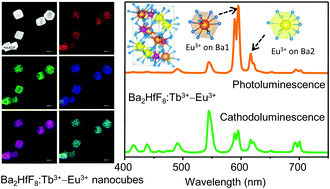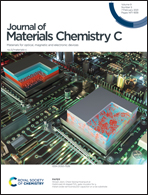Dopant site-dependent luminescence from rare-earth doped dibarium octafluorohafnate Ba2HfF8 nanocubes for radiation detection†
Abstract
Development of new host materials containing heavy elements for radiation detection is highly desirable. In this work, dibarium octafluorohafnate, Ba2HfF8, doped with rare-earth ions, was synthesized as cube-shaped nanocrystals via a facile hydrothermal method. The host lattice contains two Ba2+ crystallographic sites, and dopants on these sites exhibit site-dependent photoluminescence (PL), cathodoluminescence (CL) and X-ray excited radioluminescence (RL) characteristics. Single doping contents were optimized as 25 mol% Tb3+ and 5 mol% Eu3+. In Ba2HfF8:Tb3+–Eu3+ codoped nanocrystals, preferrable occupation of Eu3+ and Tb3+ at two different Ba2+ sites in the host lattice was observed. The nanocubes exhibited enhanced emissions over micron sized particles. In PL, the presence of Tb3+ ions significantly enhanced the emission intensity of Eu3+ ions due to energy transfer from the Tb3+ to Eu3+ ions, while under high-energy irradiation in CL or RL, Tb3+ emission was intensified. X-ray induced RL with afterglow in seconds was observed. It was found that the codoped sample showed higher sensitivity than the singly doped sample, indicating that codoping is an effective strategy to develop a scintillator with this host structure for high-energy radiation detection.



 Please wait while we load your content...
Please wait while we load your content...